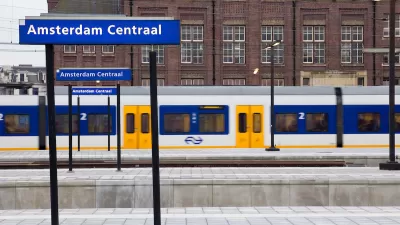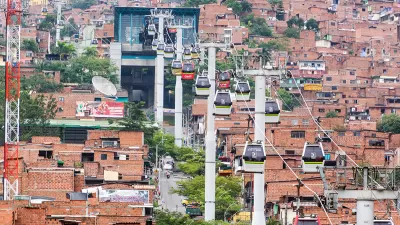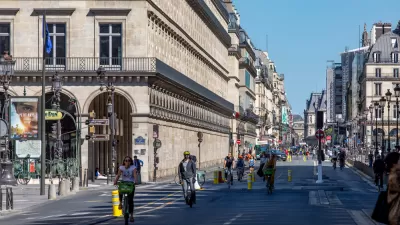"How Paris Became Paris: The Invention of the Modern City," by Joan DeJean, is full of creative insights on the symptoms of urban modernity as well as bold statements about how Paris came to be one of the world's great cities.

In the middle decades of the 1600s, a rash of cloak thefts struck Paris. One minute, a businessman would be swaddled in ermine, fashioned by a predecessor to Hermés or Chanel, with a soft collar drawn up to his brow. The next minute, he would find himself bracing against the wind coming off the Seine, with his prized possession flapping down the street, powered by an alien set of legs.
This, argues Joan DeJean, was progress.
 Cloak-thievery in the 17th century was serious business, and increasingly common. Every element of these crimes signaled the advent of a new type of urban environment, which DeJean, a professor of Romance Languages at the University of Pennsylvania, reverently describes in How Paris Became Paris: The Invention of the Modern City.
Cloak-thievery in the 17th century was serious business, and increasingly common. Every element of these crimes signaled the advent of a new type of urban environment, which DeJean, a professor of Romance Languages at the University of Pennsylvania, reverently describes in How Paris Became Paris: The Invention of the Modern City.
The cloak: a symbol of upward mobility, flirtation, and self-promotion, and a creation of the burgeoning luxury-goods industry. Business: a novel means of social mobility. The nighttime: accessible because Paris invented street lighting. The venue: thefts were rampant on the Pont Neuf, the social heart of the city. The opportunity: never before in history, claims DeJean, had the mere act of strolling around a city, purely to enjoy its people, commerce, and architecture, been considered a recreational activity.
Anyone who writes about Paris naturally gets to draft off the city's grandeur, so DeJean has an unfair advantage. Even so, she impressively achieves her goal: to explain Paris—specifically the extraordinary developments of the 1600s—without demystifying it. Though her field of expertise is French literature, DeJean has a sharp eye for everything from infrastructure and finance to haute couture and romance, and a profound talent for drawing connections between them.
DeJean initially establishes a crucial difference between Paris and its most obvious rival. London grew as an amalgam of villages: Westminster, Kensington, and so forth. Paris was conceived, from the start, as a unified city, growing radially from its Medieval center. The improvements of the 17th century were therefore civic improvements—funded centrally, available to all.
DeJean begins with a chapter apiece on the three most important of these improvements: the Pont Neuf, the Place des Vosges, and the Ille San Louis.
The Seine had been spanned by other bridges, most of which were flimsy and financed by shops along their sides (as on Florence’s Ponte Vecchio). The Pont Neuf was wider, longer, and more impressively engineered than any of its predecessors had been. It included balconies, a monumental statue of Henri IV, a broad plaza mid-span, and the world's first sidewalks. DeJean calls the bridge the first great public space in Europe: "for the first time, the monument that defined a city was an innovative urban work rather than a cathedral or a palace.”
On it, vendors sold, pickpockets thieved. Buskers, comedians, painters, vaudevillians, and poets plied their arts. The wealthy cruised in their carriages, and the rest strolled. News and gossip traveled even more quickly than did foot traffic, and it came back again as newspapers sold on the bridge. It came back yet again as protest and revolution. Theater companies performed entire plays above the Seine.
It was on the Pont Neuf that Parisians could behold their city’s rooftops, steeples, and buttresses for the first time. "Technology and urban planning had thus created the notion of a cityscape, an urban landscape, a magnificent scene made by man rather than nature," writes DeJean. "The landscape of Paris, became a masterpiece."
The Pont Neuf may be a bridge masquerading as a square, but the Place des Vosges fulfilled its purpose completely. It was explicitly public, and an uncommonly large open space in a city where many people’s lives could be measured just a few square meters. Henri IV meant for the place to be beautiful, functional, and fun—three virtues that had never been developed in concert before. The place was surrounded by "cutting-edge" residential architecture, and, unlike most Medieval squares, not focused on a particular monument or religious building.
The Ille San Louis started life as an uninhabited smudge in the middle of the Seine. By 1640, this virgin land became a master-planned community, as if the city of New York opened up Central Park for subdivision. Designed holistically (the first plans were drawn in 1614), its right-angled streets form, in miniature, the world’s first urban grid. The scale of the streets and the uniformity of the architecture resulted in the city’s most fashionable addresses and what is considered, to this day, the most romantic corner of Paris.
These big three were just the most prominent of many developments. Other included a tree-lined cours that replaced the city walls, public gardens (such as the Tuileries, replete with benches), and the expansion, straightening, and re-alignment of many of the city’s Medieval streets.
DeJean exults in describing these developments in part because she is pursuing a fierce agenda: that of knocking Baron Haussmann off his pedestal. Nearly everything, claims DeJean, that Haussmann gets credits for—primarily the construction of his great boulevards in the 1850s—first came about in the 1600s. It was then that the first Champs Elysee was built. The word "boulevard" was invented. Even Haussmann’s Etoile, where 12 streets converge on the Arc du Triomphe, is an expansion of an earlier plaza.
Much of it was under the direction of Jean-Baptiste Colbert appointed by Louis XIV in 1664 to the multipotent position of Superintendent of Buildings, Arts, and Manufactories. DeJean describes him as the equivalent of planning director and minister of culture—Robert Moses with a loom. Colbert imposed his plans "without the wholesale destruction associated with Paris' second major redesign in the nineteenth century." He instigated "a refashioning of virtually the entire urban design within those walls, to an integrated, systematic master plan for Paris' development."
And Haussmann’s accomplishments? "Largely derivative," reports DeJean.
Contrary to the grievances expressed a century later, the French crown was the driving force behind these improvements. DeJean describes Henri IV as a benevolent, enlightened dictator and "(took) seriously both the practical value of urban works and the role such projects could play in bettering the lives of the city's inhabitants."
Meanwhile, Parisian entrepreneurs invented no less than three technologies and systems that are crucial to urban life: intra-city mail delivery (with curbside mailboxes), street lighting (suspended lanterns), and public transportation (stage coaches on fixed routes). These developments gave birth to brand-new words too, among them, "Sidewalk, city square, pedestrian, traffic jam, balcony, boulevard, avenue, embankment--even street."
DeJean predictably equates modernism with innovation. But, for her, the modernism of 17th century Paris entails much more: social mobility, literal mobility, and the burgeoning triumph of secularism and commerce over both church and crown, as “money and financial influence would increasingly trump all traditional forms of social status.” Parisians of the 17th century busied themselves not just with accepting their lot in life but also in improving and enjoying themselves in the process.
Of course, no one enjoyed themselves more than did the rich.
In the first quarter of the 17th century, France waged a series of costly wars. A generation of financiers arose to make loans to the crown, which is the original meaning of the word "finance." The other group that made a bundle during these heady days were real estate developers. Paris thus set the trend for many other major world cities.
It's not that poor people aren't important. It's that, for DeJean, they just aren't interesting. Then, as now, the divide between rich and poor was banal in its immensity. The tradesmen who built financiers’ mansions did so under de facto wage slavery. Gentrification was a fact of life. The city became "a paradise for the rich and hell for the poor...infinite numbers of shops full of beautiful things you were dying to buy."
Covetousness brings DeJean to her true love: fashion. In Paris' egalitarian streets, parks, and shopping arcades, attire took on new meaning. It was in this age that dress truly proclaimed the man, or woman, regardless of the station in which he or she was born. Backed by Colbert, French labels became world-renowned. (DeJean writes that Colbert "rebooted the French economy," to use an uncharacteristically gauche neologism.) The conspicuous display of fashion, paired with the freedom to move about the city, endowed Paris with its air of romance—sexy, but, somehow, not louche. The chance for flirtation was always only a footstep away.
DeJean exposes a truism of cosmopolitan life: frivolity is important. She traces the rise of the upper class and their use of the city because it they who used it most distinctively. She makes no value judgments and casts no aspersions. She celebrates the fact that fad-obsessed nouveaux riches were in fact nouveau: some had risen from penury to become self-made financiers and real estate developers. Others became fashion designers. DeJean convincingly advances a version of the argument that Florida and Currid have been making about the centrality of the “creative class” in today’s urban economies. (It’s not necessarily a prescription for urban planners in other cities, but it does remind them that a city’s success depends on things that elude bureaucratic metrics.)
The city’s transformations were not lost on Parisians. DeJean draws many of her conclusions from their own chronicles of life in the city. DeJean refers liberally to the arts of the era, particularly painting and drama. Images of bustling streets are not throwaway scenes of "everyday life." As she makes clear, the artists who painted the crowds on the Pont Neuf or who included a pulley-suspended lantern in the background of a street scene knew they were capturing a new age. Dramas scrutinized and poked fun at the city's fad-obsessed coquettes, aventurieres, and femmes fatale, all stereotypes invented in the strolling-and-flirting era.
As she exults in all these developments, DeJean's chronology can be confusing at times. She writes according to theme and not sequence, so it's not always clear which civic innovation was happening when, or which innovations were taking place at the same time. Her larger point may be that 17th century Paris was not an exercise in sequential cause-and-effect. Everything, it seems, was happening at once.
DeJean assigns plenty of superlatives to Paris: best, most, first. At every turn, she makes plausible, appealing arguments. She also makes claims like, "every parkway, every grand avenue in today's major cities, has its origin in that rampart of green [thecours] for which they laid the groundwork in 1669." It’s Paris, so it’s at least half-convincing. But surely similar wonders were coming along in other places. Surely noteverygreen space ineveryother city was inspired by Paris?
What of London, where the world's greatest dramas were performed for all comers on a nightly basis? What about Amsterdam, where the world's greatest merchant class was on the rise? What about Antwerp? DeJean does not claim to be conducting a rigorous comparative study—as if "romance" and "modernity" could be quantified—but some acknowledgement of Paris' rivals would be nice. We may never know just how romantic Paris really is.
Thus the history of Paris is propelled, as ever, by its myth and mystique. Hang on to your cloaks.
How Paris Became Paris: The Invention of the Modern City
Jean DeJean
Bloomsbury USA
320 pages
$30.00

Pennsylvania Mall Conversion Bill Passes House
If passed, the bill would promote the adaptive reuse of defunct commercial buildings.

World's Largest Wildlife Overpass In the Works in Los Angeles County
Caltrans will soon close half of the 101 Freeway in order to continue construction of the Wallis Annenberg Wildlife Crossing near Agoura Hills in Los Angeles County.

U.S. Supreme Court: California's Impact Fees May Violate Takings Clause
A California property owner took El Dorado County to state court after paying a traffic impact fee he felt was exorbitant. He lost in trial court, appellate court, and the California Supreme Court denied review. Then the U.S. Supreme Court acted.

Indy Bikeshare System Turns 10, Expands to E-Bikes
Pacers Bikeshare riders logged over 700,000 rides since the system launched in 2014.

Coming Soon to Ohio: The Largest Agrivoltaic Farm in the US
The ambitious 6,000-acre project will combine an 800-watt solar farm with crop and livestock production.

New York’s Deadliest Neighborhoods for Pedestrians
Pedestrian deaths rose last year, but remain below pre-2020 levels.
City of Costa Mesa
Licking County
Barrett Planning Group LLC
HUD's Office of Policy Development and Research
Mpact Transit + Community
HUD's Office of Policy Development and Research
Tufts University, Department of Urban and Environmental Policy & Planning
City of Universal City TX
ULI Northwest Arkansas
Write for Planetizen
Urban Design for Planners 1: Software Tools
This six-course series explores essential urban design concepts using open source software and equips planners with the tools they need to participate fully in the urban design process.
Planning for Universal Design
Learn the tools for implementing Universal Design in planning regulations.


























